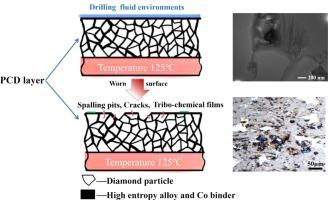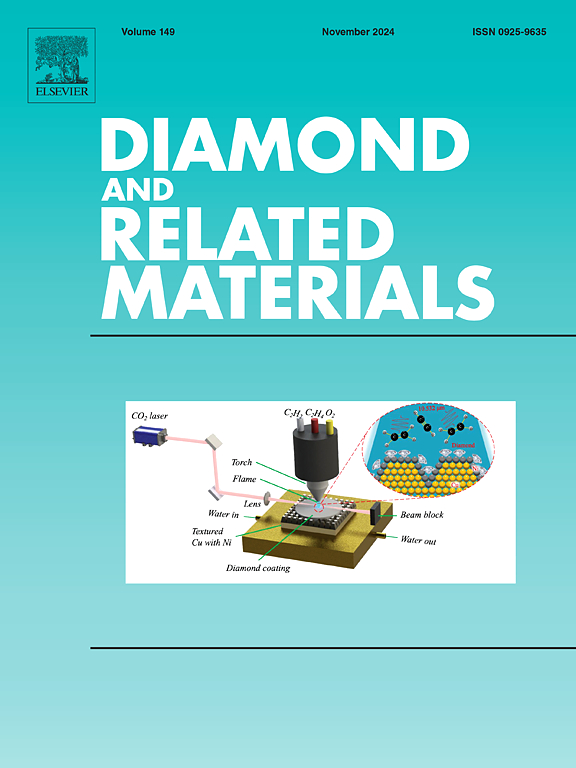High-temperature tribological behaviors of polycrystalline diamond under water-based drilling fluid environments
IF 4.3
3区 材料科学
Q2 MATERIALS SCIENCE, COATINGS & FILMS
引用次数: 0
Abstract
For purposes of investigating the high-temperature tribological behaviors of polycrystalline diamond (PCD) thrust bearings under simulated deep drilling conditions, tribological experiments have been conducted under various drilling fluid environments, including pure water-based, potassium-based, calcium-based, sodium-based, and mud drilling fluids. The linear reciprocating mode of CSM-TRN model tribo-tester has been used to reveal the lubrication mechanisms of these fluids at a working temperature of 125 °C. Experimental results demonstrate the PCD compacts tested under pure water-based drilling fluid environment show a higher friction coefficient and wear rate, compared with that tested under potassium-based, calcium-based, sodium-based and mud drilling fluids. The high coverage of the graphitization tribo-chemical films can hinder the oxidization and exfoliation of the PCD, which finally leads to the wear rates under potassium-based, calcium-based, sodium-based and mud drilling fluids are lower than that under pure water-based drilling fluid. Compared with that calcium-based, sodium-based and mud drilling fluids, the PCD compacts tested under potassium-based drilling fluid environment exhibit a low friction coefficient of 0.073 and a low wear rate of 3.15×10−2 mg/N·m resulting from the synergistic effect of low viscosity of drilling fluid, a smooth worn surface and the lubrication of graphitization tribo-chemical films.

聚晶金刚石在水基钻井液环境下的高温摩擦学行为
为了研究聚晶金刚石(PCD)推力轴承在模拟深层钻井条件下的高温摩擦学行为,我们在各种钻井液环境下进行了摩擦学实验,包括纯水基、钾基、钙基、钠基和泥浆钻井液。使用 CSM-TRN 型摩擦磨损试验机的线性往复模式揭示了这些流体在 125 ℃ 工作温度下的润滑机理。实验结果表明,与钾基、钙基、钠基和泥浆钻井液相比,在纯水基钻井液环境下测试的 PCD 密实材料具有更高的摩擦系数和磨损率。石墨化三化学膜的高覆盖率阻碍了 PCD 的氧化和剥离,最终导致钾基、钙基、钠基和泥浆钻井液环境下的磨损率低于纯水钻井液环境下的磨损率。与钙基钻井液、钠基钻井液和泥浆钻井液相比,在钾基钻井液环境下测试的 PCD 压实物摩擦系数低至 0.073,磨损率低至 3.15×10-2 mg/N-m,这是钻井液低粘度、光滑的磨损表面和石墨化三化学膜的润滑作用协同作用的结果。
本文章由计算机程序翻译,如有差异,请以英文原文为准。
求助全文
约1分钟内获得全文
求助全文
来源期刊

Diamond and Related Materials
工程技术-材料科学:综合
CiteScore
6.00
自引率
14.60%
发文量
702
审稿时长
2.1 months
期刊介绍:
DRM is a leading international journal that publishes new fundamental and applied research on all forms of diamond, the integration of diamond with other advanced materials and development of technologies exploiting diamond. The synthesis, characterization and processing of single crystal diamond, polycrystalline films, nanodiamond powders and heterostructures with other advanced materials are encouraged topics for technical and review articles. In addition to diamond, the journal publishes manuscripts on the synthesis, characterization and application of other related materials including diamond-like carbons, carbon nanotubes, graphene, and boron and carbon nitrides. Articles are sought on the chemical functionalization of diamond and related materials as well as their use in electrochemistry, energy storage and conversion, chemical and biological sensing, imaging, thermal management, photonic and quantum applications, electron emission and electronic devices.
The International Conference on Diamond and Carbon Materials has evolved into the largest and most well attended forum in the field of diamond, providing a forum to showcase the latest results in the science and technology of diamond and other carbon materials such as carbon nanotubes, graphene, and diamond-like carbon. Run annually in association with Diamond and Related Materials the conference provides junior and established researchers the opportunity to exchange the latest results ranging from fundamental physical and chemical concepts to applied research focusing on the next generation carbon-based devices.
 求助内容:
求助内容: 应助结果提醒方式:
应助结果提醒方式:


